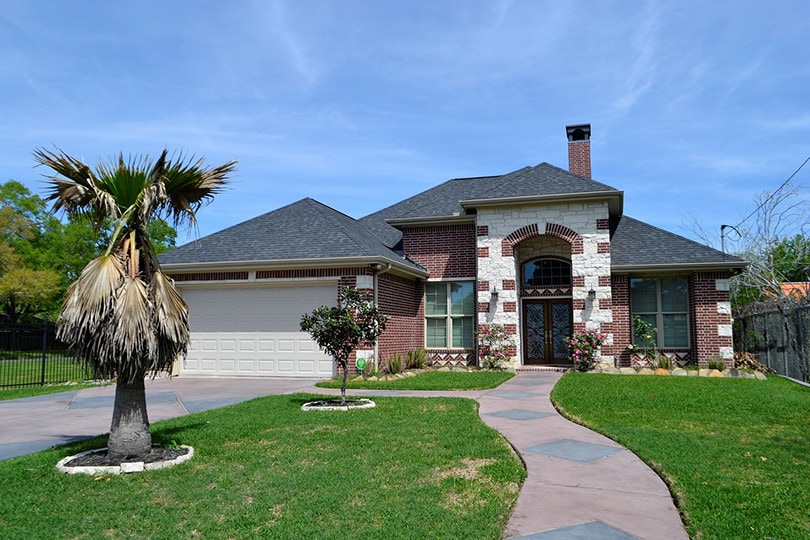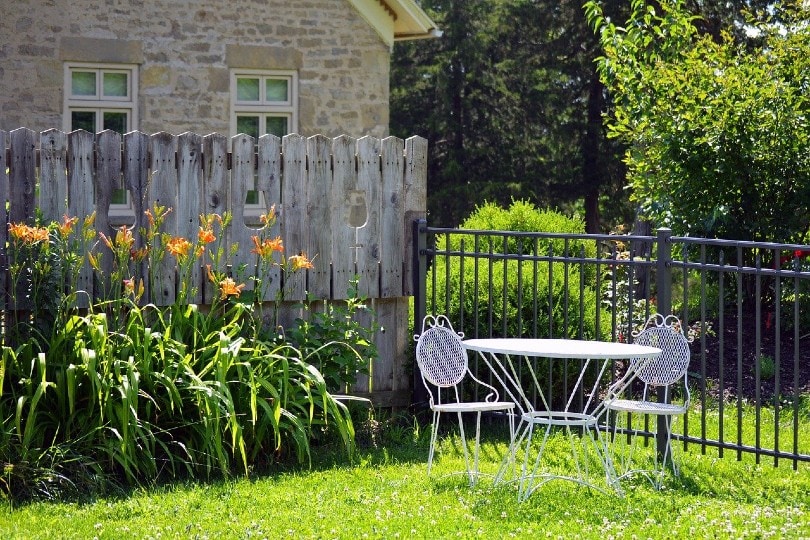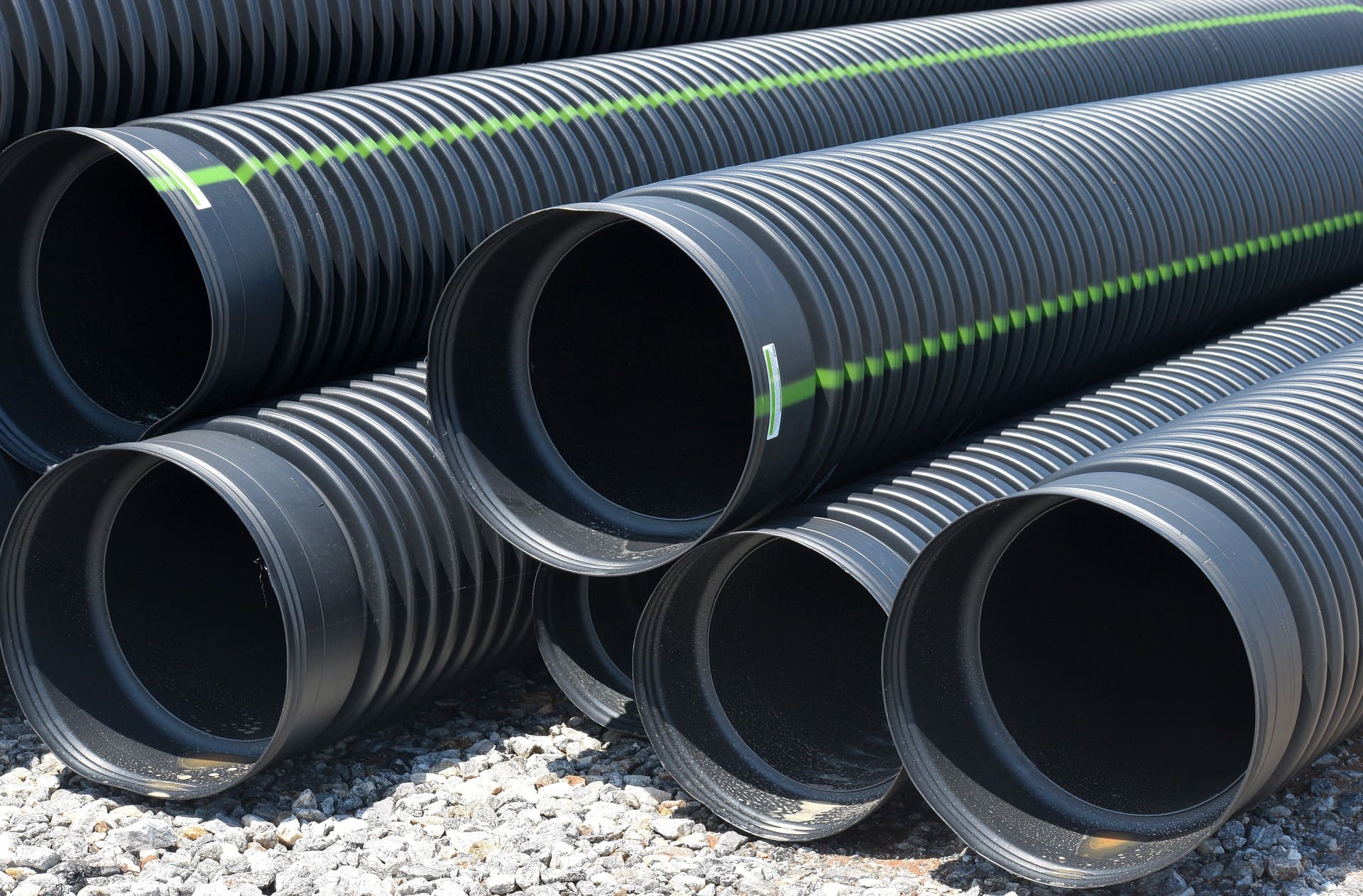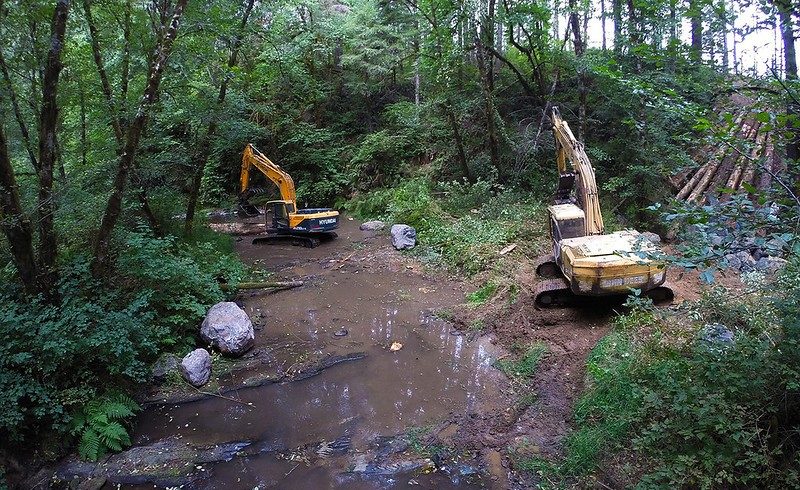7 Most Popular Types of Yard Drains (With Pictures)
-

- Last updated:

Even if you don’t live in a rainy area, a proper landscape drainage system is still a must. When it fails, you end up with puddles of water all over the yard, dead flowers/plants, damage to the house, and even a bad smell—we’ve all been there! And although you might already have a working yard drain, it’s probably not ideal for your garden/backyard.
That’s why it’s so important to know what kind of setup you need. In this guide, we’ll introduce you to the most common and effective drainage systems, including the French drain, catch basins, dry creeks, and more. Some are cheaper, while others are harder to build. And, they all have their pros and cons. So, pay extra attention to our detailed reviews to find the perfect option for your yard!
 The 7 Most Popular Types of Yard Drains
The 7 Most Popular Types of Yard Drains
1. Grassy Swale

| Cost | Very Low |
| Difficulty | Low/Moderate |
| Estimated Completion Time | 1–2 Days |
| What You’ll Need | Sod, New Plantings |
Excess water saturates the soil, gets muddy, and attracts bugs and pests. A grassy swale can help solve the issue. Essentially, it’s a slope or a trench, a big, long, and narrow one, and you can build it in a day or two with your own hands. A shovel is all you’ll need, and the standard dimensions are 6–12 inches deep and 4–5 feet wide.
Also, ensure a 1–2 inch drop every 10–12 inches for a steady flow. Now, swales direct water to ditches, drains, or boggy areas. So, it would be best if there were lots of plants in that area to avoid erosion. Grassy swales aren’t very strong against floods and heavy rain, though. That’s why the plants that grow there (or, rather, their roots) have to be strong. Otherwise, the soil will turn into a trench.
- Adds character to the landscape
- No expensive materials required
- A DIY project: can be built manually
- Not very reliable
- Weak against heavy rainstorm
2. French Drain

| Cost | Average |
| Difficulty | Moderate |
| Estimated Completion Time | 1–2 Days |
| What You’ll Need | Gravel, Filter Fabric, Pipes |
On average, it takes 2–3 days to build a French drain with a set of pipes, filter fabric (wrap it around the pipes for extra protection), and lots of gravel. French drains don’t visually affect the garden in any way. Plus, they are pretty small yet serve for many years, if not decades. As for the downsides, these drains clog quite often.
And it’s usually a challenge to clean the pipes. Also, while the installation/building process isn’t very hard, and French drains don’t cost a fortune, we do recommend renting a trencher. It will help you get the job done much faster. See that the drain is 9–12 inches wide and 18–20 inches deep. Dig a small trench, put a pipe through, and connect it to a drain outside of your garden.
- No visual impact on the yard
- Compact, yet highly efficient
- Durable, can last for decades
- Tends to clog quite often
- You might have to rent a trencher
3. The Dry Well System
| Cost | Low |
| Difficulty | Low/Moderate |
| Estimated Completion Time | 24–36 Hours |
| What You’ll Need | Filter Fabric, Topsoil, Gravel, Post-Hole Digger, Downspouts |
Dry wells have always been the “little brothers” to French drains. First, they are cheaper; second, they take less time to build. Again, you’ll need a filter fabric, some gravel, and topsoil, along with pipes or downspouts to direct the water. A dry well is a big underground basin, and the gravel is there to help with water absorption. Over time, that water spreads over the soil and groundwater.
If you rent a big enough post-hole digger, you’ll be able to build a dry well in less than two days. This is important: the well needs to be reasonably deep and wide to hold around 50 gallons of water (at least 3 feet deep and 3–4 feet in diameter) so that the well doesn’t overflow. Furthermore, since you’ll be using pipes again, they will clog from time to time.
- Can be dug in a day with a hole digger
- Serves as a water conservation system
- Must be deep and wide to work
- Clogging is a common issue
4. Plastic Tubes (Corrugated)

| Cost | Very Low |
| Difficulty | Low |
| Estimated Completion Time | 24 Hours |
| What You’ll Need | Corrugated Tubes |
Wait, didn’t we just talk about tubes when discussing dry wells and French drains? Well, yes, but corrugated plastic tubes are a different story. They’re very durable, flexible, and easily handle temperature extremes. Sadly, they’re not particularly crush-resistant: so, it would be wise to keep them underground. On top of that, these tubes are even harder to clean when clogged.
Corrugated tubes are also cheap and easy to work with. They’re not at all heavy and can be easily moved around. You should be able to have them installed in less than 24 hours. Plus, they are capable of handling large amounts of water. Just remember to keep height variations to a minimum for proper water flow. Place the tubes right underneath your downspouts, and that’s it!
- Highly flexible and bendable
- Lightweight, easy to move around
- Height variations are going to be a problem
- Not that durable: can be crushed
- Hard to clean when cluttered
5. Channel Drains

| Cost | High |
| Difficulty | High |
| Estimated Completion Time | 3–4 Days |
| What You’ll Need | Dry Well System, Drains, Pipes |
This right here is the most expensive drainage system for your garden. So, will it be a worthy investment, or not? Well, channel drains are extremely efficient against runoff. Plus, they last for a very long time. And they’re even more resilient than corrugated tubes. The installation process is rather long, however, and does require expertise.
Besides, you won’t be able to customize these drains unless you dig everything out, which, again, costs a lot. For a channel drain, make sure you have the actual drains, pipes, and an advanced dry well system. Or, just dig a deep enough trench and put the drains over it. Channel drains work in any environment, if you connect the pipes to a full-fledged drainage system outside.
- Efficient and long-lasting
- Not afraid of environmental factors
- Prevent water collection in the yard
- Expensive and time-consuming to install
- No room for any modifications
6. Catch Basin
| Cost | Average |
| Difficulty | Moderate |
| Estimated Completion Time | 1–2 Days |
| What You’ll Need | PVC Pipes, Catch Basin |
In some ways, a catch basin, also known as a yard drain, is the cheaper and less advanced version of channel drains. It can be installed in 1–2 days at a moderate pace. All you’ll need is a set of PVC pipes to lead excess surface water away to a catch basin. The best thing about it—is you can easily connect a basin to other drainage systems (like a dry well, for example) and thus increase its efficiency.
Besides, yard drains are known to boost the value of a house/property. However, their capacity is rather limited, and on their own, catch basins won’t do much good for a large landscape. Sinkholes are another common issue. Also, you might have to deal with a pest infestation, as yard drains tend to attract bugs.
- Easy to integrate with other drainage systems
- Increases the value of your property
- Rather weak on its own
- Attracts bugs and pests
- Known to cause sinkholes
7. Dry Creek

| Cost | Very Low |
| Difficulty | Moderate |
| Estimated Completion Time | 2–3 Days |
| What You’ll Need | Drainage Rocks/Stones, Mortar |
If you live in an arid location, a dry creek could be the perfect drainage system for you. What is a dry creek, exactly? It’s a trench, but one filled with river rocks and stones of various sizes that absorb water. When properly built, a dry creek will not only be effective against heavy rainstorms but also serve as a decorative element for the garden. Start by outlining the bed, then dig it out and bring in the stones.
To keep the stones in bed, we recommend using mortar. Be very thorough with this; otherwise, the rocks will be washed away by the runoff, ruining the whole thing. A dry creek can be built over the weekend (in 2–3 days) and is almost as cheap as a grassy swale. And you won’t have to try and hide it because creeks add a nice “rustic” touch to a landscape.
- Looks great; easily fits in any environment
- Handles large amounts of water
- Simple, hassle-free installation
- The rocks require strong anchoring
- Might wash away during heavy rain
Plants, Barrels, And Rain Gardens: Cheap DIY Yard Drains
If you don’t have the time, budget, or expertise for any of the drainage systems we just discussed, there are still some options on the table:
- Plant water-absorbing plants. The focus here will be on exactly that—plants that absorb maximum amounts of water. Thankfully, there are dozens of plants out there that look and smell beautiful. Go for native plants, as they’ve proven to be very effective. The list includes Inkberry, blue elderberry, daylily, violet, red maple, weeping willow, and purple coneflower.
- Build a rain garden. This one is for the gardeners that have steep slopes on their property. Rain gardens add a lovely touch to any landscape and serve as a decent (and 100% natural) drainage system. Essentially, it collects water during a rainstorm/flood, and then the soil slowly absorbs it. Mix different types of soil to achieve the desired effect. As a bonus, rain gardens attract all kinds of birds and butterflies.
- Try aerating the yard. All you have to do here is dig tiny holes in different spots around the yard that will then trap excess water. This is the most ancient and cheapest drainage system. On the downside, an aerated garden or backyard with small indentations doesn’t look that great.
- Install a water barrel. You can even try building one but do keep in mind that water barrels can only collect water from downspouts.
What About Pavement Drainage?
You could try this, of course, but we wouldn’t necessarily recommend it. First, paving materials usually cost a lot. Second, while they do work, if you live in a humid and rainy area, you’ll be disappointed by this system. Here’s how the pavement drainage works: you add layers of quick-draining gravel. Next, you put paving materials with tiny gas on top of the gravel.
The water “sneaks through” these holes and keeps the surface nice and dry. You can go with concrete, asphalt, or plastic, but, again, this drainage system’s efficiency leaves a lot to be desired.
 Conclusion
Conclusion
If you’re an avid gardener or just like to keep your property in stellar condition, you need to make sure the drainage system is up to the task. There are lots of different options out there, and while certain types of land greatly benefit from dry creeks or grassy swale, that won’t always work. Sometimes, you’ll have to pay a lot more to have channel drains installed.
It also comes down to your current budget for the project and how much time and effort you’re willing to invest. If you’re looking for the middle of the lane, catch basins and French drains will be a decent place to start. Or, if you’re into something cheaper, go with plastic tubes or a dry well.
Featured Image Credit: ArtisticOperations, Pixabay
Contents
 The 7 Most Popular Types of Yard Drains
The 7 Most Popular Types of Yard Drains